Link About It: This Week’s Picks
Philippe Starck’s private space homes, lie-flay beds in economy class, knitting climate data into scarves and more

Farewell to Mathematician Katherine Johnson, Crucial “Hidden Figure” at NASA in the ’60s Space Race
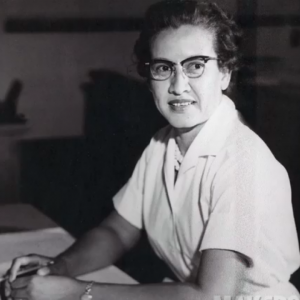 From her time as a childhood math prodigy in West Virginia to her crucial role as a “computer” at NASA, where her calculations helped lead astronauts into orbit and then the moon, black mathematician Katherine Johnson was a pioneering figure in spaceflight. Johnson’s work was critical to NASA’s earlier successes—especially during the space race—but they wouldn’t get mainstream recognition until President Barack Obama awarded her the Presidential Medal of Freedom in 2015. Johnson’s story was then chronicled in the film Hidden Figures two years later. Johnson has passed away at age 101. Read more about her the Washington Post.
From her time as a childhood math prodigy in West Virginia to her crucial role as a “computer” at NASA, where her calculations helped lead astronauts into orbit and then the moon, black mathematician Katherine Johnson was a pioneering figure in spaceflight. Johnson’s work was critical to NASA’s earlier successes—especially during the space race—but they wouldn’t get mainstream recognition until President Barack Obama awarded her the Presidential Medal of Freedom in 2015. Johnson’s story was then chronicled in the film Hidden Figures two years later. Johnson has passed away at age 101. Read more about her the Washington Post.
Knitters Chronicle Climate Change With “Temperature Scarves”
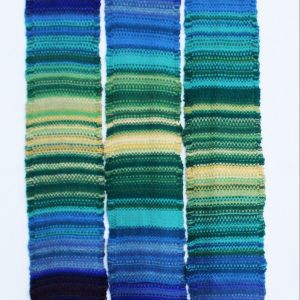 From the “sky scarf” of the early aughts to the Tempestry Project today, knitters tap into climate change for guidance in their stitching. While the former accessory is about aesthetic inspiration, the latter aims to preserve data reported by the National Oceanic and Atmospheric Administration through “temperature scarves.” These are two examples of the way colorful yarns tie into the climate crisis and our reaction to it. Knitting has been used as a teaching aid, as a means of reflection, and even to make a statement—as with BlackRock CEO Larry Fink’s “temperature scarf” at Davos. Read more at The New York Times.
From the “sky scarf” of the early aughts to the Tempestry Project today, knitters tap into climate change for guidance in their stitching. While the former accessory is about aesthetic inspiration, the latter aims to preserve data reported by the National Oceanic and Atmospheric Administration through “temperature scarves.” These are two examples of the way colorful yarns tie into the climate crisis and our reaction to it. Knitting has been used as a teaching aid, as a means of reflection, and even to make a statement—as with BlackRock CEO Larry Fink’s “temperature scarf” at Davos. Read more at The New York Times.
NASA’s Philippe Starck-Designed Private Space Homes
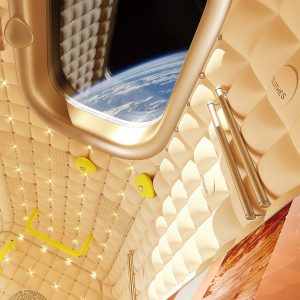 “My vision is to create a comfortable egg, friendly, where walls are so soft and in harmony with the movements of the human body in zero gravity,” enterprising designer Philippe Starck says of his latest commission: private accommodation on the International Space Station (ISS) for commercial tourists. NASA partnered with Axiom Space on the project, who then tapped Starck. The project should be complete by 2024—and populated by private citizens who participate in training at Axiom’s Houston facility. After, “Trips will last roughly 10 days, with eight of them spent aboard the ISS,” according to Architectural Digest, where you can read more.
“My vision is to create a comfortable egg, friendly, where walls are so soft and in harmony with the movements of the human body in zero gravity,” enterprising designer Philippe Starck says of his latest commission: private accommodation on the International Space Station (ISS) for commercial tourists. NASA partnered with Axiom Space on the project, who then tapped Starck. The project should be complete by 2024—and populated by private citizens who participate in training at Axiom’s Houston facility. After, “Trips will last roughly 10 days, with eight of them spent aboard the ISS,” according to Architectural Digest, where you can read more.
The Continued Quest for Pain-Free Microneedles
 Produced through a process of 3D printing with polymers—altogether referred to as “4D printing” because of its core of programmable, shape-shifting material—rapidly developing microneedles may replace painful hypodermic needles in the next decade. Professor Howon Lee, who has lead the research from Rutgers University, has filed a patent on this new technology, which produces hollow needles that are barbed, much like the stinger of a bee. They can pierce skin, anchor in and stay put during delivery of medicine or retrieval of blood—without causing pain. A patch composed of several microneedles could be worn to administer larger doses of medicine—though this particular idea isn’t new (it first piqued interest outside the scientific community, for use with vaccines, in 2015). Read more at Fast Company.
Produced through a process of 3D printing with polymers—altogether referred to as “4D printing” because of its core of programmable, shape-shifting material—rapidly developing microneedles may replace painful hypodermic needles in the next decade. Professor Howon Lee, who has lead the research from Rutgers University, has filed a patent on this new technology, which produces hollow needles that are barbed, much like the stinger of a bee. They can pierce skin, anchor in and stay put during delivery of medicine or retrieval of blood—without causing pain. A patch composed of several microneedles could be worn to administer larger doses of medicine—though this particular idea isn’t new (it first piqued interest outside the scientific community, for use with vaccines, in 2015). Read more at Fast Company.
Marchi Architects’ Woodhouse 2.0 for Long Island
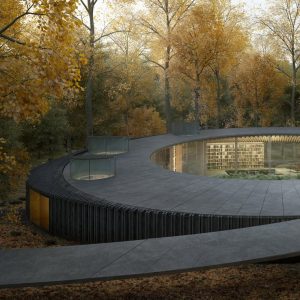 With a radial footprint, Woodhouse 2.0, by Paris-based design studio Marchi Architects, coils into the forested topography of New York’s Long Island. The residential proposal employs timber and texture materials to lend warmth within. The open-concept design, undisturbed circulation and ample window space embrace natural light, a hidden central courtyard and the woods outside, too. See more images at designboom.
With a radial footprint, Woodhouse 2.0, by Paris-based design studio Marchi Architects, coils into the forested topography of New York’s Long Island. The residential proposal employs timber and texture materials to lend warmth within. The open-concept design, undisturbed circulation and ample window space embrace natural light, a hidden central courtyard and the woods outside, too. See more images at designboom.
NASA’s Public Design Challenge For Venus Exploration
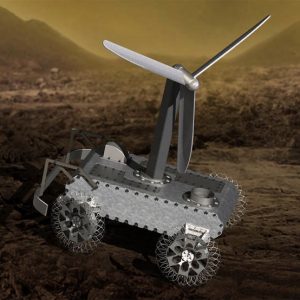 Supported by an internal grant, a new creative challenge posed by NASA asks the general public to submit ideas for an “innovative obstacle avoidance sensor” that will be featured on a future Venus Rover Concept. The planet’s notoriously rough surface will prove quite difficult to maneuver around and weather and pressure conditions are extreme. Officially titled “Exploring Hell: Avoiding Obstacles on a Clockwork Rover,” the prompt requires that all innovations be powered by an energy source other than electronics, since the planet’s surface clocks in at 840° Fahrenheit and all electronic systems fail just above 200° Fahrenheit. The first-place winner will receive $15,000 and the title of, though perhaps unofficially, NASA engineer. Read more at NASA.
Supported by an internal grant, a new creative challenge posed by NASA asks the general public to submit ideas for an “innovative obstacle avoidance sensor” that will be featured on a future Venus Rover Concept. The planet’s notoriously rough surface will prove quite difficult to maneuver around and weather and pressure conditions are extreme. Officially titled “Exploring Hell: Avoiding Obstacles on a Clockwork Rover,” the prompt requires that all innovations be powered by an energy source other than electronics, since the planet’s surface clocks in at 840° Fahrenheit and all electronic systems fail just above 200° Fahrenheit. The first-place winner will receive $15,000 and the title of, though perhaps unofficially, NASA engineer. Read more at NASA.
The Smithsonian Institution Releases 2.8 Million High-Resolution Images
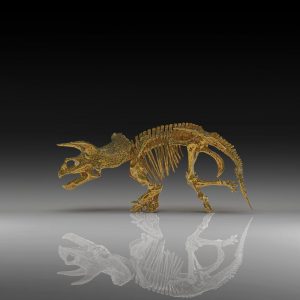 For the first time, the Smithsonian Institution has granted access to 2.8 million high-resolution images from “all 19 Smithsonian museums, nine research centers, libraries, archives and the National Zoo,” for use by the general public. They’ve done so through a new open access platform that allows users to download anything they’d like free of charge. This is just the beginning, as “the institution continues to digitize its collection of 155 million items and counting.” Read more at Smithsonian Magazine.
For the first time, the Smithsonian Institution has granted access to 2.8 million high-resolution images from “all 19 Smithsonian museums, nine research centers, libraries, archives and the National Zoo,” for use by the general public. They’ve done so through a new open access platform that allows users to download anything they’d like free of charge. This is just the beginning, as “the institution continues to digitize its collection of 155 million items and counting.” Read more at Smithsonian Magazine.
Herman Miller and Logitech G Collaborate on Gaming Furniture
 Herman Miller might be best known for producing the acclaimed designs of Charles and Ray Eames (among many others), but the company continues to bring its skilled eye into new—and unexpected—spaces. Through a partnership with Logitech G, Herman Miller will produce seating for esports and gaming scenarios, fusing feedback from athletes and gamers with research done in tandem by the two parties. “We’re excited to combine our ergonomic, research-driven approach with Logitech G’s excellence in technology and innovation,” Herman Miller’s Chief Marketing Officer, Tim Straker, explains. Read more at Engadget.
Herman Miller might be best known for producing the acclaimed designs of Charles and Ray Eames (among many others), but the company continues to bring its skilled eye into new—and unexpected—spaces. Through a partnership with Logitech G, Herman Miller will produce seating for esports and gaming scenarios, fusing feedback from athletes and gamers with research done in tandem by the two parties. “We’re excited to combine our ergonomic, research-driven approach with Logitech G’s excellence in technology and innovation,” Herman Miller’s Chief Marketing Officer, Tim Straker, explains. Read more at Engadget.
Air New Zealand’s Lie-Flat Beds for Economy Travel
 A development that may benefit many passengers on long-haul flights, Air New Zealand has filed patent and trademark applications for a lie-flat sleeping pod prototype designed for economy-class travelers. Referred to as the Economy Skynest, it’s structured like stacked bunk beds. The airline will determine whether or not to proceed with the concept in 2021, after it has assessed the needs of its Auckland–New York route, which takes a whopping 17 hours and 40 minutes when headed westbound. Read more at AFAR.
A development that may benefit many passengers on long-haul flights, Air New Zealand has filed patent and trademark applications for a lie-flat sleeping pod prototype designed for economy-class travelers. Referred to as the Economy Skynest, it’s structured like stacked bunk beds. The airline will determine whether or not to proceed with the concept in 2021, after it has assessed the needs of its Auckland–New York route, which takes a whopping 17 hours and 40 minutes when headed westbound. Read more at AFAR.
Super-Storm Early Warnings From Four Extreme Weather-Tracking Satellites
 In both 2016 and 2018, Lockheed Martin launched one next-generation weather tracking satellite—known as GOES, or Geostationary Operational Environmental Satellites—capable of detecting almost every bolt of lightning in the Western Hemisphere. Two more of these 6,000-pound satellites will be launched in 2021 and 2024. With all four in place, they’ll be able to monitor electrical activity in the atmosphere—and the data they amass will help to power NASA and NOAA’s weather forecasting models. The information provided by the $10.8 billion fleet could then enhance our understanding of and preparation for super-storms. Read more at Wired, where you can see photographer Christopher Payne’s exclusive imagery.
In both 2016 and 2018, Lockheed Martin launched one next-generation weather tracking satellite—known as GOES, or Geostationary Operational Environmental Satellites—capable of detecting almost every bolt of lightning in the Western Hemisphere. Two more of these 6,000-pound satellites will be launched in 2021 and 2024. With all four in place, they’ll be able to monitor electrical activity in the atmosphere—and the data they amass will help to power NASA and NOAA’s weather forecasting models. The information provided by the $10.8 billion fleet could then enhance our understanding of and preparation for super-storms. Read more at Wired, where you can see photographer Christopher Payne’s exclusive imagery.
Link About It is our filtered look at the web, shared daily in Link and on social media, and rounded up every Saturday morning.












